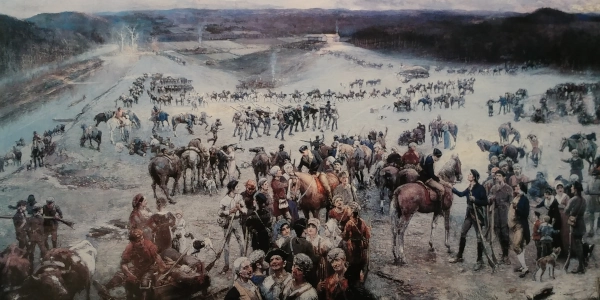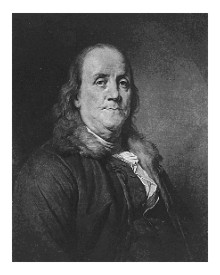
Top: George Washington. Commander of the Continental Army and 1st President of the U.S.A. Courtesy NARA. Right: Surrender at Yorktown. Courtesy Library of Congress.
Sponsor this page for $100 per year. Your banner or text ad can fill the space above.
Click here to Sponsor the page and how to reserve your ad.
-
Timeline
1780 Detail
September 25, 1780 - The march begins this date at Sycamore Shoals on the Watauga River (Tennessee) by the Over-Mountain Men militia of the American Revolution under Colonels James McDowell, John Sevier, Isaac Shelby, and William Campbell as they move toward the Battle of Kings Mountain in South Carolina.

Many of these men had been leasing their land from the Cherokee since they were south of an imaginary line the British had scratched between themselves and the Cherokee in the 1770 Treaty of Lochaber. They had been ordered to leave by the British in towns like the Watauga settlement at Sycamore Shoals (Elizabethton), Carter's Valley (Kingsport), and Nolichucky (Greeneville). The British not only wanted them gone from these illegal settlements, but so did some of the Cherokee. Despite the conflicts, they had formed the first independent community in continental North America, in East Tennessee, with the Watauga Association in 1772.
However, by 1776, the concern was more with the fight going on between American settlers in the northeast and mid-atlantic regions that had just come south in force in 1780. By the summer of 1780, they had captured Fort Thickety on the Pacolet River, as well as taken part in the Patriot victory at Musgrove Mill. But as the British brutalized Patriots in other parts of South Carolina, many of the Overmountain Men had gone home to harvest their farms by fall. However, when they heard of the routing that the patriots had taken at Camden, words spread that they needed to gather again.

The Gathering at Sycamore Shoals
General Lord Cornwallis, commander of the British southern strategy, moved his army into North Carolina in September 1780 with Major General Patrick Ferguson ordered to advance west with one thousand troops and loyalists. His goal for the settlers was to get them to quit opposing the British, or "he would march his army over the mountains, hang their leaders, and lay their country waste with fire and sword."
The patriot leaders now had a rallying cry, convincing heretofore reluctant Scotch-Irish patriot frontiersmen to join the fight. On September 24, 1780, the Virginia militia under William Campbell were mustered at Abingdon, Virginia. By the next day, Isaac Shelby, John Sevier, and Campbell had gathered their militias at Sycamore Shoals, joining North Carolina militia under Charles McDowell. The next day they headed toward Kings Mountain, gathering more troops along the way at Quaker Meadows. On September 27, 1780, the Overmountain Men crossed the Roan Mountain over new snow. Two men deserted to warn Ferguson that a force was heading his way.
It was agreed as they marched that William Campbell would take overall command of the various militias. Thinking that Ferguson was at Gilbert Town, they approached on October 4, 1780, but he was gone. However, their continuous pursuit of Ferguson's one thousand men could not be thwarted. The patriot Overmountain Men found him at Kings Mountain.
End of the March
The Overmountain Men, loyal to the Continental Army, but not technically part of them, had marched three hundred and thirty miles to reach Kings Mountain.
Today you can visit several important historic sites that tell the story of the Overmountain Men. Of course, there's the national park for the outcome battle at Kings Mountain, the Sycamore Shoals State Historic Park that tells the story of the historic muster there, as well as the Overmountain Victory National Historic Trail, including the Abington Muster Grounds.
Photo above: Painting "Gathering of Overmountain Men at Sycamore Shoals, 1915, Lloyd Branson. Courtesy National Park Service and Library of Congress. Below: Photo of the Statue of an Overmountain Man by Jon Mark Estep at Sycamore Shoals State Historic Park in Elizabethton, Tennessee, USA, 2009, Brian Stansberry. Courtesy Wikipedia Commons C.C. 3.0. Sources: National Park Service; Wikipedia Commons; Sycamore Shoals State Historic Park.








